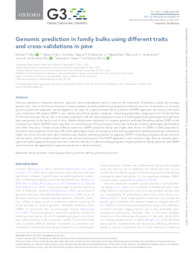Genomic prediction in family bulks using different traits and cross-validations in pine.
Genomic prediction in family bulks using different traits and cross-validations in pine.
Autoria: RIOS, E. F.; ANDRADE, M. H. M. L.; RESENDE JR, M. F. R.; KIRST, M.; RESENDE, M. D. V. de; ALMEIDA FILHO, J. O. E. de; GEZAN, S. A.; MUNOZ, P.
Resumo: Genomic prediction integrates statistical, genomic, and computational tools to improve the estimation of breeding values and increase genetic gain. Due to the broad diversity in mating systems, breeding schemes, propagation methods, and unit of selection, no universal genomic prediction approach can be applied in all crops. In a genome-wide family prediction (GWFP) approach, the family is the basic unit of selection. We tested GWFP in two loblolly pine (Pinus taeda L.) datasets: a breeding population composed of 63 full-sib families (5?20 individuals per family), and a simulated population with the same pedigree structure. In both populations, phenotypic and genomic data was pooled at the family level in silico. Marker effects were estimated to compute genomic estimated breeding values (GEBV) at the individual and family (GWFP) levels. Less than six individuals per family produced inaccurate estimates of family phenotypic performance and allele frequency. Tested across different scenarios, GWFP predictive ability was higher than those for GEBV in both populations. Validation sets composed of families with similar phenotypic mean and variance as the training population yielded predictions consistently higher and more accurate than other validation sets. Results revealed potential for applying GWFP in breeding programs whose selection unit are family, and for systems where family can serve as training sets. The GWFP approach is well suited for crops that are routinely genotyped and phenotyped at the plot-level, but it can be extended to other breeding programs. Higher predictive ability obtained with GWFP would motivate the application of genomic prediction in these situations.
Ano de publicação: 2021
Tipo de publicação: Artigo de periódico
Unidade: Embrapa Café
Palavras-chave: Genomics, Melhoramento Genético Vegetal, Pineus, Reprodução Vegetal, Statistical models
Observações
1 - Por padrão são exibidas publicações dos últimos 20 anos. Para encontrar publicações mais antigas, configure o filtro ano de publicação, colocando o ano a partir do qual você deseja encontrar publicações. O filtro está na coluna da esquerda na busca acima.
2 - Para ler algumas publicações da Embrapa (apenas as que estão em formato ePub), é necessário ter, no celular ou computador, um desses softwares gratuitos. Sistemas Android: Google Play Livros; IOS: iBooks; Windows e Linux: software Calibre.
Acesse outras publicações
Acesse a Base de Dados da Pesquisa Agropecuária (BDPA) para consultar o acervo completo das bibliotecas da Embrapa.

